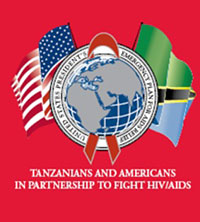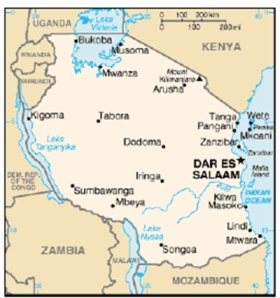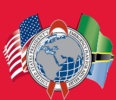| Country Profile: Tanzania
 |
President George W. Bush's
Emergency Plan for AIDS
Relief is the largest commitment
ever by any nation for an
international health
initiative dedicated to
a single disease-a
five-year, $15 billion,
multifaceted approach to
combating the disease around the world.
U.S. Department of
State
U.S. Agency for
International
Development
U.S. Department of
Defense
U.S. Department of
Commerce
U.S. Department of
Labor
U.S. Department of
Health and Human
Services
Peace Corps
Mailing address:
SA-29, 2nd Floor
2201 C Street, NW
Washington, DC 20522-2920
www.PEPFAR.gov
| |
Country Profile: Tanzania
| HIV/AIDS in Tanzania
Adults and Children Living with HIV: 1.4 million1
AIDS Deaths (Adults and Children): 140,0001
AIDS Orphans: 1.1 million1 As the largest country in East Africa, Tanzania bears a large share of the global HIV/AIDS pandemic, with an estimated HIV prevalence of 8.8 percent among adults aged 15-49.2 Among the 1.6 million people living with HIV/AIDS, 70.5 percent are 25-49 years old and; 15 percent are 15-24 years. Sixty percent of new infections occur among youth aged 15-24 years.2 |
|
 |
|
Though nearly 160,000 deaths were attributed to HIV/AIDS in 20032, it is estimated that only one in five cases are actually reported, grossly understating the extent of the epidemic. Of the 800,000 women who gave birth in health care facilities in 2002, 13.3 percent were HIV-positive. Among women attending antenatal clinics in 2002, 9.6 percent were HIV-positive.
U.S. Government Response
The U.S. Government (USG) strategy builds on existing structures and plans in concert with the Government of Tanzania and other donors. Tanzania's development of a national policy on HIV/AIDS marked a milestone in its response to the epidemic, which was reinforced by concurrent establishment of a high level, multi-sectoral commission in the Prime Minister's office (the Tanzanian Commission on AIDS or TACAIDS). On the mainland, TACAIDS is the strategic leader and coordinator. The Zanzibar AIDS Commission is responsible for overall leadership and coordination of the response on the islands.
The USG is an active member of a major multilateral and bilateral support coordination group: the Development Partner Group, HIV/AIDS subgroup. The aim of the group is to enhance commitment and coordination among international partners- efforts to support the accelerated national response to HIV/AIDS.
The USG response in Tanzania focuses on several core themes, including:
- Valuing and utilizing the strengths of all partners;
- Improving service delivery, including policy formulation;
- Empowering human and institutional capacity; and
- Implementing the "Three Ones" - one national AIDS strategy; one national AIDS coordinating authority; and, one agreed upon national AIDS monitoring and evaluation system.
Recognizing the global HIV/AIDS pandemic as one of the greatest health challenges of our time, President George W. Bush announced the U.S. President's Emergency Plan for AIDS Relief (Emergency Plan/PEPFAR) in 2003 - the largest international health initiative in history by one nation to address a single disease. Under the leadership of the U.S. Global AIDS Coordinator, USG agencies implement the Emergency Plan, working collaboratively as strong, interagency country teams under the direction of the U.S. Ambassador. These teams capitalize on the expertise of each USG agency and leverage partnerships with host governments, multilateral institutions, nongovernmental organizations (NGOs) and the private sector to implement effective programs for combating HIV/AIDS and ensure efficient use of USG resources.
Tanzania is one of 15 focus countries of the Emergency Plan, which collectively represent approximately 50 percent of HIV infections worldwide. Under the Emergency Plan, Tanzania received more than $70.7 million in Fiscal Year (FY) 2004 and nearly $108.8 million in FY2005 to support a comprehensive HIV/ AIDS prevention, treatment and care program. In FY2006, the United States plans to provide approximately $129.9 million to support Tanzania's efforts to combat HIV/AIDS.
1 UNAIDS, Report of the Global AIDS Epidemic, 2006
2 UNAIDS, Report of the Global AIDS Epidemic, 2004.
| |
 |
Emergency Plan Achievements in Tanzania to Date |
|
Challenges to Emergency Plan Implementation
The greatest challenge facing the health sector is inadequate human resources to deliver quality health services to the Tanzanian population. A second challenge is poverty. Tanzania has formulated its second Poverty Reduction Strategy Paper to reinforce its commitment to overcoming poverty. Tanzania also continues to struggle with the issue of corruption, with the health care sector being ranked as the second most corrupt sector in the country by the country's Economic and Social Research Foundation. Due in part to the vast size of the country, health services do not currently meet acceptable quality standards. Overall, while services may be available, the human and physical infrastructure is in need of improvement to allow for better quality patient care. |
| # of individuals reached with community outreach HIV/AIDS prevention programs that promote Abstinence and/or Being Faithful in FY20051 |
5,636,600 |
| # of individuals reached with community outreach HIV/AIDS prevention activities that promote Condoms and related prevention services in FY20051 |
4,002,500 |
| # of USG condoms shipped in Calendar Year 2005 |
18,582,000 |
| # of pregnant women receiving prevention of mother-to-child HIV transmission (PMTCT) services since the beginning of the Emergency Plan3,4 |
217,200 |
| # of pregnant women receiving antiretroviral prophylaxis for PMTCT since the beginning of the Emergency Plan3,5 |
8,600 |
| # of individuals receiving counseling and testing (in settings other than PMTCT) in FY20053,4 |
524,400 |
| # of HIV-infected individuals who received palliative care/basic health care and support in FY20053 |
126,200 |
| # of Orphans and Vulnerable Children (OVCs) who were served by an OVC program in FY20053,6 |
286,400 |
| # of individuals receiving downstream site-specific support for treatment as of September 30, 20061 |
37,000 |
| # of individuals receiving upstream system strengthening support for treatment as of September 30, 20062 |
7,300 |
|
Note: Numbers may be adjusted as attribution criteria and reporting systems are refined. Numbers above 100 are rounded to nearest 100.
1 Number of individuals reached through downstream site-specific support includes those receiving services at U.S. Government-supported service delivery sites.
2 Number of individuals reached through upstream systems strengthening includes those supported through contributions to national, regional and local activities such as training, laboratory support, monitoring and evaluation, logistics and distribution systems, protocol and curriculum development.
3 Total results combine individuals reached through downstream and upstream support.
4 It is possible that some individuals were counseled and tested more than once.
5 It is possible that some pregnant women received antiretroviral prophylaxis more than once over the two-year period, e.g. HIV positive women who were pregnant more than once.
6 The number of OVC served in Tanzania represents a large increase from the results reported in FY2004, due to increased upstream support to develop a National Framework for the Care of Most Vulnerable Children and a National Action Plan for OVC. |
Critical Interventions for HIV/AIDS Prevention
- Supported over 217 facilities offering prevention of mother-to-child HIV transmission (PMTCT) services, contributing to over 80 percent of program expansion in FY2005.
- Supported the Tanzanian Ministry of Health's initiation of Universal Safe Precaution and Injection Safety programs in five referral hospitals and 60 district facilities, training or retraining a total of 1,289 health workers in the general management of safety injection supplies and proper waste handling.
- Supported programs that have reached approximately 5.6 million individuals through community outreach HIV/AIDS prevention programs that promote abstinence and/or being faithful.
- Provided technical assistance to support efforts of the Government of Tanzania to develop a national strategy to guide condom social marketing.
- Strengthened programming for high-risk groups by initiating prevention activities along transport corridors, worksites, and borders; increasing male involvement for risk reduction; and piloting prevention programs with the police.
Critical Interventions for HIV/AIDS Treatment
- Provided technical assistance to the Government of Tanzania on the accurate quantification of antiretroviral drug needs for the national antiretroviral treatment (ART) program. Supports the procurement of first and second line treatment regimens, a commitment valued at over $4.5 million in FY2005.
- Worked with the Government of Tanzania using innovative strategies to address the human capacity shortage, including strengthening the management of health facilities and deploying an emergency action plan for placing unemployed skilled workers, such as retirees, in critical shortage areas.
- Supported the renovation of 18 laboratories, including the outfitting of all six national referral laboratories with high volume CD4, hematology and chemistry equipment.
Critical Intervention for HIV/AIDS Care
- Advocating for new guidelines that allow provider-initiated, opt-out HIV testing, and pursued new ways of reaching Tanzanians with mobile counseling and testing units.
- Supported care services for 36,000 people in 26 districts not served by the National AIDS Control Programme, which serves over 12,000 people living with HIV through community care programs in approximately 43 districts in Tanzania.
- Collaborated with the Government of Tanzania to set up a network that links village-level "Most Vulnerable Children Committees" to district and national coordinating mechanisms, ensuring that the needs of vulnerable children in the community are being met by coordinating and providing direction to orphan and vulnerable children service programs and social workers in the community.
|
| |  |  |



